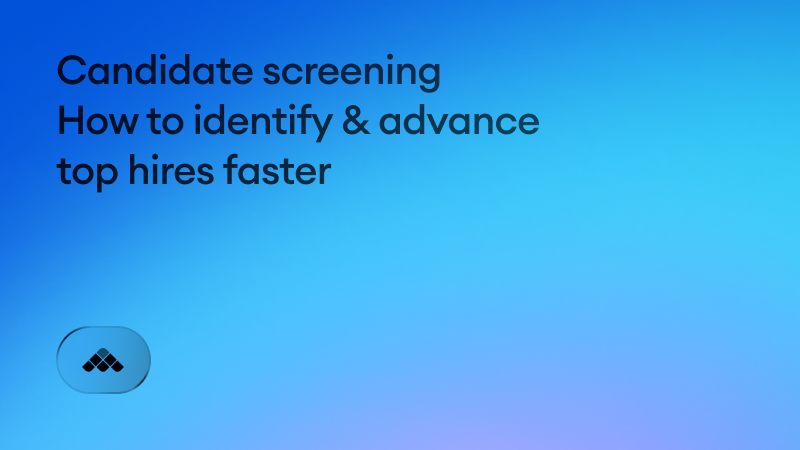Every hiring process starts with hope and ends with a decision. But in between lies a mountain of resumes, messages, and interviews that demand attention. Recruiters need to move fast, but every shortcut risks missing the right hire.
Screening candidates is one of the most critical and time-consuming parts of recruiting. Every week brings dozens of new applicants who might just be the one—and often hundreds more who aren’t.
You need to quickly identify the right people without letting qualified applicants slip through the cracks, in a way that’s fair, structured, and data-driven. The key is in balancing speed and precision.
This guide will help you design a more efficient, consistent approach to screening candidates, and use automation and insights to save time. All while improving quality of and time to hire.
Key takeaways
- Efficiency and fairness go hand in hand. Structured rubrics and clear evaluation criteria let you breeze through candidate pipelines without sacrificing quality or introducing bias.
- AI and automation unlock scalable screening. The right tools free recruiters from manual review tasks, helping you identify and progress top candidates in a fraction of the time.
- Data-driven screening improves hiring outcomes. When insights from interviews and applications are captured automatically, you can spot trends, refine processes, and consistently make better hiring decisions.
What is candidate screening?
Candidate screening is the process of evaluating applicants to determine whether they meet the essential qualifications and expectations for a role. It generally sits between sourcing and interviewing. This is where you narrow down your applicant pool to identify who’s worthy of following the full hiring path.
Screening can take several forms: reviewing resumes, conducting phone screens, analyzing assessment results, or using AI tools to surface the strongest profiles. One simple goal is to eliminate people who don’t fit. But more importantly, you prioritize the candidates who most closely match your hiring criteria.
Done right, candidate screening helps talent teams:
- Move faster through high-volume pipelines
- Maintain objectivity and reduce interviewer bias
- Improve collaboration between recruiters and hiring managers
- Deliver a stronger experience to every applicant
A modern screening process balances efficiency with fairness. It ensures that hiring decisions are based on evidence, not vibes. That means clear rubrics, consistent evaluation, and transparent communication throughout.
With the right systems and tools in place, screening becomes less about sorting, and more about pinpointing exactly who you want.
8 best practices to screen candidates efficiently
Screening candidates efficiently doesn’t mean rushing through applications or relying on gut instinct. It requires a consistent, structured, and data-driven approach that lets you find high-potential talent faster.
Here are eight best practices to help recruiters and hiring teams streamline the process without compromising on quality.
1. Target precisely during sourcing
The most efficient screening starts before screening even begins. The quality of your candidate pool depends on how precisely you source. Use clear job descriptions, defined skill requirements, and targeted sourcing filters to attract candidates who closely match what you’re looking for.
Leverage referral programs, talent databases, and AI-driven sourcing tools to pre-qualify talent. The narrower and more accurate your sourcing inputs, the less time you’ll waste filtering out poor fits later.
2. Involve hiring managers early
Early alignment prevents late-stage friction. Collaborate with hiring managers to define the must-haves, dealbreakers, and evaluation criteria before screening begins. You can then formalize these collaborations with rubrics and scorecards, per the next section.
When everyone agrees on what “good” looks like, you reduce back-and-forth, avoid duplicate assessments, and ensure decisions are made faster and with more confidence.
3. Build clear rubrics and scorecards
Consistency is key to objective screening. Create structured rubrics that define what “qualified” looks like for each role. Rubrics ensure every recruiter and hiring manager evaluates candidates against the same measurable criteria, not personal preferences.
Interview scorecards also make collaboration easier. Before interviews even start, everyone can see how candidates will be assessed on skills, experience, and cultural alignment. This removes ambiguity and makes the “why” behind decisions transparent.
And you know upfront whether it’s worth bringing candidates through to the next round.
4. Use automation and AI tools
Manual screening is one of the biggest bottlenecks in recruiting. Modern AI-powered screening tools can automatically parse resumes to pluck out the key requirements you’re looking for, and eliminate those who just don’t cut it.
AI is also essential during screening calls and early interviews. Recruiters can automatically capture and summarize interview conversations, surfacing insights like candidate motivations, concerns, and alignment with role requirements. And crucially, without the usual hours of notetaking and formatting.
Automation amplifies human effort, freeing recruiters to focus on high-value interactions instead of repetitive filtering and extra admin.
5. Screen for must-haves, not nice-to-haves
Overfiltering can be just as damaging as underfiltering. Many qualified candidates get ruled out simply because they don’t check every box. Focus on the non-negotiable requirements: the skills, experience, and competencies that truly predict success.
A mindset shift from “perfect match” to “best potential” opens your funnel to a wider and often more diverse talent pool. You can always train for nice-to-haves once the high-potential person comes onboard.
6. Standardize communication
Speed and clarity in communication make a huge difference in candidate experience. Create templates for rejection emails, status updates, and next steps, so you can respond quickly and consistently.
Timely communication signals respect. And even candidates who aren’t selected will remember a professional, transparent process.
Your hiring process likely involves at least a handful of interviewers and stakeholders. You all need to present a united front externally.
7. Track and refine your process
Treat your screening process like a living system. Measure time-to-screen, screen-to-interview conversion rates, and candidate drop-off rates to spot bottlenecks or bias.
By analyzing this data, you can adjust criteria, improve communication, and even experiment with new tools. Continuous optimization leads to smarter, faster screening over time.
8. Prioritize the candidate experience
A fast, efficient process is great. But it also needs to be enjoyable for and respectful to applicants. Keep candidates informed, provide feedback where possible, and avoid ghosting.
Even candidates who aren’t selected can become advocates for your brand if they feel they were treated fairly. Remember: every interaction reflects your company’s reputation.
Efficient screening comes from structure, alignment, and smart use of technology. When you combine clear criteria with automation and empathy, you build a process that’s both scalable and human.
Why AI and automation are essential
We mentioned this above, but it’s worth going into further detail. Recruiters today face an impossible balancing act: hire faster, hire better, and deliver a great candidate experience, all at once.
But manual screening methods simply don’t scale. Reading resumes, fiddling with interview notes, and managing feedback loops across multiple stakeholders can eat up hours that could be spent engaging with candidates.
That’s why AI and automation have become essential to modern hiring. The right tools free recruiters from repetitive tasks and give them the insights needed to make confident, data-driven decisions.
Here’s how automation transforms candidate screening:
- Source a rich pipeline automatically: AI sourcing tools can take a simple job description, interview scorecard, or a few bullet points, and build a hoard of interesting, strong-fit candidates. All while you do something more valuable.
- Instantly surface top candidates: AI reviews resumes and applications at scale, highlighting those who meet key criteria within minutes.
- Spot hidden talent: Intelligent algorithms identify transferable skills and potential that manual reviews often miss.
- Ensure fairness and consistency: Automated workflows apply the same criteria across all applicants, reducing bias and improving equity.
- Accelerate collaboration: Shared dashboards and automated summaries make it easier for recruiters and hiring managers to stay aligned.
- Make data actionable: AI tools turn raw information into insights that show what’s working, and what’s slowing you down.
Automation helps you maintain speed and structure without sacrificing quality. When your tools handle the busywork, your team can focus on building relationships, refining your employer brand, and closing the best candidates faster.
How Metaview helps recruiters screen smarter
Metaview takes AI-driven screening a step further. It turns your candidate conversations into structured, searchable, and actionable data.
Here’s how Metaview streamlines the screening process:
- AI Sourcing for a rich trove of interesting candidates: Based on brief notes or a job description, you get unlimited, targeted candidates to reach out to right away.
- Automatic transcription and summarization: Every interview is recorded, transcribed, and summarized automatically, so you can review key insights in minutes instead of hours.
- AI-generated highlights and insights: Metaview identifies the most relevant skills, motivations, and potential concerns raised in interviews, helping you quickly determine fit.
- Consistent, structured evaluation: Standardized interview notes make it easier to compare candidates and ensure all interviewers are assessing against the same criteria.
- Faster collaboration with hiring managers: Instant summaries and searchable transcripts let hiring teams review candidate performance without waiting for follow-ups.
- Data-driven optimization: Metaview surfaces trends and patterns from across your interviews to refine screening criteria and improve outcomes.
In short, Metaview helps recruiters progress top candidates faster and more confidently. You get back the hours lost to manual review, without losing the nuance and depth of real conversations.
Cut straight through to the best candidates faster
Candidate screening doesn’t have to be slow, manual, or uncertain. With clear criteria, structured processes, and smart AI use, you can evaluate applicants faster, fairer, and more consistently. All without sacrificing quality.
Tools like Metaview turn the information already in your pipeline into insight, helping your team focus on what really matters: connecting with great people and hiring them before the competition does.
A faster, smarter, and more human screening process is possible, and it starts with better data.
Streamline your screening process and hire faster. Try Metaview for free.
FAQs
1. What’s the difference between candidate screening and shortlisting?
Screening is the broader process of evaluating all applicants to determine whether they meet essential qualifications. Shortlisting happens after screening, when you select the top candidates who’ll move forward to interviews.
Screening helps narrow the funnel; shortlisting finalizes who’s worth deeper assessment.
2. How long should the candidate screening process take?
For most roles, the screening stage should take 3–5 business days. Longer timelines increase the risk of candidate drop-off or losing top talent to faster competitors.
Automation and AI tools help compress this window significantly by surfacing qualified candidates instantly.
3. How can recruiters reduce bias during screening?
Bias often enters when screening relies on subjective impressions or inconsistent criteria. Recruiters can reduce bias with structured rubrics, blind resume reviews, and AI-driven scoring to focus only on relevant skills and experience. Platforms like Metaview also ensure every interview is evaluated consistently across all candidates.
4. What are the best tools to automate candidate screening?
The best screening tools depend on your tech stack, but common categories include:
- AI platforms (like Metaview) for interview insights and structured evaluation.
- Applicant tracking systems (ATS) such as Greenhouse or Ashby for managing applications.
- Assessment tools like TestGorilla or Codility for technical evaluations.
Integrating these tools ensures your pipeline runs smoothly and your team can focus on human decision-making, not manual filtering.


